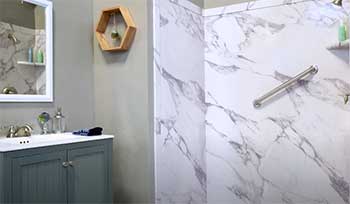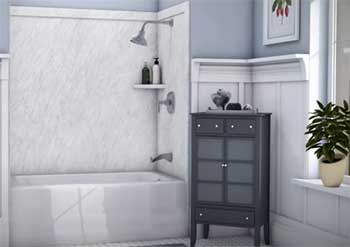A little luxury in your daily routine can make a significant difference, and one such luxury is enjoying a refreshing shower in a beautiful, well-appointed bathroom.
The shower space often becomes a focal point, and the walls you choose will significantly impact its style, longevity, and upkeep. Two popular choices amongst homeowners are Sentrel and FlexStone shower walls.
In this article, we’ll dissect both these options, diving deep into their pros and cons, to help you make an informed choice.
A Brief Comparison Table
| Aspects | Sentrel | FlexStone |
| Material | Poly substrate digitally imaged to look like stone | Composite material with digital imagery and protective top layer |
| Design Choices | Extensive range of colors and patterns | Multiple designs but less variety than Sentrel |
| Durability | High durability with resistance to water, mold, mildew | Resistant to cracks, chips, fading |
| Installation | Recommended professional installation | Easy DIY installation |
| Cost | Premium pricing | Budget-friendly |
| Feel | Authentic stone-like feel | Good, but not as authentic as Sentrel |
Exploring Sentrel Shower Walls
Sentrel is a system of panels designed to create stunning bath and shower walls that replicate the look of natural stone, but without the associated problems.
It’s a composite material consisting of a poly substrate, digitally imaged to give the impression of genuine stone, granite, or marble.
The Pros of Sentrel

- Design Versatility: Sentrel excels in design versatility. It offers a wide range of colors and patterns, mimicking natural stone, and fits seamlessly in any bathroom decor.
- Durability: Sentrel is built to last. It is resistant to water, mold, and mildew, making it a practical choice for wet environments. Its poly substrate material doesn’t easily crack or chip, promising years of aesthetics and functionality.
- Easy Maintenance: The non-porous surface prevents water seepage, minimizing the chances of hard water stains or soap scum. A simple wipe-down keeps your shower looking fresh and clean.
The Cons of Sentrel
- Cost: While Sentrel shower walls score high on the convenience and aesthetics scale, they come with a hefty price tag. The superior quality and design versatility justify the cost for many, but it may be a deterrent for those on a strict budget.
- Professional Installation: Sentrel recommends professional installation to maintain warranty validity. So, do-it-yourself enthusiasts may feel a little left out.
Journey into the FlexStone Universe
FlexStone is a unique composite material made of high-resolution digital imagery and a protective, clear top layer that mimics the look and feel of real stone. It’s a versatile solution designed for quick and easy installation on shower walls.
The Pros of FlexStone
- Durability and Longevity: FlexStone products are known for their longevity. The material is resistant to cracks, chips, and fading. As a result, your shower walls will look new for a long time.
- Easy Installation: One of FlexStone’s most attractive features is its installation ease. With its lightweight panels and straightforward instructions, even novices can handle this DIY project.
- Cost-Effective: If you’re looking for a budget-friendly option, FlexStone is a good bet. It provides the elegance of stone without burning a hole in your pocket.
The Cons of FlexStone
- Less Luxurious Feel: While FlexStone replicates the stone look effectively, the feel isn’t quite the same. For those seeking an authentic stone experience, FlexStone may fall short.
- Limited Design Options: FlexStone offers fewer design options compared to Sentrel, limiting your ability to personalize your shower space.
Key Differences Between Sentrel And FlexStone Shower Walls
Though Sentrel and FlexStone might seem similar, they have some distinct differences that set them apart. Let’s explore them in detail.
- Material Composition

While both Sentrel and FlexStone use digitally imaged stone, the base materials differ.
Sentrel uses a poly substrate as its base material, which offers excellent water, mold, and mildew resistance.
FlexStone, on the other hand, uses a composite material topped with a protective clear layer to create its panels, providing resistance to cracking, chipping, and fading.
- Design Versatility
Sentrel shower walls take the crown when it comes to design versatility. They offer a wide range of colors and patterns, simulating various types of natural stone, granite, and marble.
FlexStone also offers multiple designs but falls short when compared to the extensive portfolio of Sentrel.
- Installation
FlexStone outshines Sentrel in terms of installation. It’s designed for DIY enthusiasts, with lightweight panels and easy-to-follow instructions. Sentrel, on the other hand, recommends professional installation to maintain the validity of the product warranty.
- Cost
Sentrel is a premium product, and it’s priced accordingly. Its high cost reflects its design versatility, quality, and long-term durability.
FlexStone, however, positions itself as a more budget-friendly alternative. It provides the elegance of stone without the high price tag.
- Feel
While both products replicate the look of stone, they differ when it comes to the feel. Sentrel’s poly substrate gives a more authentic stone-like feel compared to FlexStone’s composite material.
While Sentrel and FlexStone have similarities, these key differences can be decisive factors when choosing between the two. Your choice will depend on your preferences in terms of design, cost, installation, and the overall feel you want for your shower space.
Frequently Asked Questions (FAQ)
Sentrel shower walls are made from a poly substrate, digitally imaged to look like genuine stone, granite, or marble. This unique composite material gives the beauty of natural stone with the durability and ease of maintenance of synthetic materials.
FlexStone is known for its durability and longevity. If properly installed and maintained, FlexStone shower walls can last many years. They’re resistant to cracking, chipping, and fading, keeping your shower looking fresh and vibrant for a long time.
FlexStone is a unique composite material composed of layers of high-resolution digital images of natural stone and a clear, protective top layer. This design gives FlexStone its distinctive look, mimicking real stone.
FlexStone is primarily used for bathroom and shower wall applications. Its easy installation, durability, and stone-like appearance make it an attractive option for homeowners seeking an affordable yet stylish solution.
Conclusion
When it comes to Sentrel and FlexStone, the choice boils down to personal preferences and budget. Both offer excellent durability, ease of maintenance, and beautiful stone-like appearances.
However, Sentrel offers more design versatility but at a higher cost, while FlexStone is more budget-friendly and easy to install. So, analyze your requirements and make the choice that best suits your needs.
Remember, a great shower can be the perfect start to your day or a relaxing end to a hectic one. Choose wisely!

